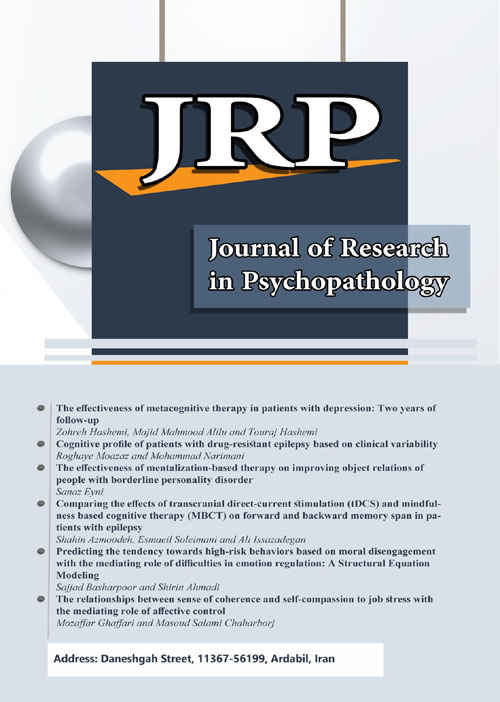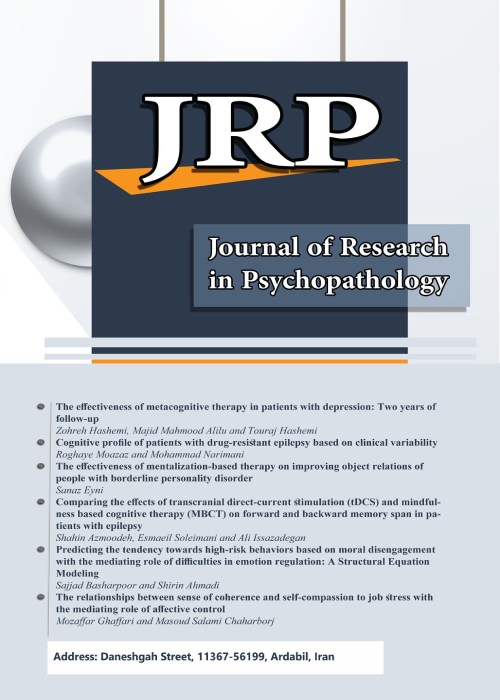فهرست مطالب

Journal of Research in Psychopathology
Volume:3 Issue: 7, Winter 2022
- تاریخ انتشار: 1401/02/14
- تعداد عناوین: 6
-
-
Pages 1-7In this study, the relationship between emotional character and depression and anxiety in patients with polycystic ovary syndrome was investigated. The present research was a descriptive-correlational study. The population of the study included all people with polycystic ovary in 2012 of Ardabil city. A sample of 100 patients was selected from among patients referring to specialized clinics and Caucasus Infertility Center. To collect the data, the scales of emotional character, Beck Depression and perceived anxiety questionnaires were used. To analyze the data, Pearson correlation and multivariate regression analysis were employed. The data analysis showed a significant positive correlation between the emotional character and depression and anxiety in the participants (p < .01). Based on the results of multivariate regression, the dimensions of emotional character were able to predict the depression and anxiety in patients with polycystic ovary syndrome (p < .01). These results have some significant implications for improving the mental health of patients with polycystic ovary syndrome. Therefore, by using the dimensions of emotional personality of patients with polycystic ovary syndrome, anxiety and depression can be reduced in them.Keywords: Emotional character, depression, anxiety, Polycystic Ovary Syndrome
-
Pages 8-14The aim of this study was to investigate the role of chronotype (morning-evening) in predicting depression and suicidal ideation. The method of this research is descriptive and correlational. The population of this research consists of all students of Shahid Madani University in the academic year 2020-2021, among whom 300 people were selected as the sample by availability sampling. Horn and Sternberg Evening-Morning Questionnaire (1976), Beck et al.'s Depression Scale (1961), and Beck Suicide Scale (1961) were used to collect the data. The data were analyzed by Pearson correlation and multivariate regression. The results of Pearson correlation indicated that there was a negative and significant relationship between chronotype variables and depression (r = -0.254) and also there was a positive and significant relationship between depression and suicidal ideation (r = 0.514). But the relationship between chronotype variables and suicidal ideation was not significant. The results of multivariate regression showed that the chronotype variable has 25% predictability of depression. The relationship revealed that chronotype variables and suicidal ideation was not statistically significant, but the indirect effect of chronotype through depression mediation was significant. Also, 26% of suicidal ideation was predictable through depression. The results indicated that having a chronotype in the evening has the ability to predict depression and with an evening chronotype the rate of depression increases. Also, the chronotype variable in the mediating role between depression and suicidal ideation can mediate the relationship between depression and suicidal ideation.Keywords: Chronotype, Evening, Morning, depression, Suicidal ideation
-
Pages 15-21Following the prevalence of the Covid-19 pandemic, people especially the elderly over the age of 65 are more vulnerable to the disease. The purpose of this study was to investigate the effectiveness of cognitive-behavioral intervention based on stress-induced immunization training in order to improve sleep quality and mental health of the older adults during pandemic lockdown. This was a quasi-experimental study with pre-test and a control group. The participants were 21 older adults with poor quality of sleep in Tehran, Iran during 2021-2022. This online study was carried out in the last week of July 2021. Snowball sampling was used to recruit the participants from one source to another. In order to develop an e-questionnaire, Whatsapp link was used, which contained close-ended items as well as Likert-scale questions on Sleep Quality Index (PSQI) and General Health Questionnaire (GHQ-12). The individuals were randomly divided into experimental (n=12) and control groups (n=9). The experimental group was trained weekly on immunization against stress based on cognitive-behavioral principles (10 weekly sessions, 45 minutes), while the control group did not receive this training. After collecting data, SPSS V. 23 was used to analyze the data (p > .05). Demographic findings showed that the number of women was more than men (24.63% men and 75.37% women) and the Mean ± SD age in the experimental group was 64.52 ± 14.83 and in the control group it was 62.54 ± 13.55, which did not differ significantly in terms of this variable (p > .05). The results showed that cognitive-behavioral intervention based on stress-induced immunization training significantly improved sleep quality and mental health in the experimental group (p < .001). Overall, the stress immunization program is an effective way to improve sleep quality and the mental health of older adults during the pandemic lockdown. Therefore, it is recommended to focus on such intervention to help vulnerable groups during this pandemic.Keywords: Stress-induced immunization training, Sleep quality, mental health, older adults, pandemic lockdown
-
Pages 22-28Patients undergoing hemodialysis experience various problems related to the complications of the disease such as physical, economic, social and psychological problems that can be the cause of mental disorders in such patients. The aim of this study was to investigate the effectiveness of tDCS brain electrical stimulation on the treatment of anxiety disorder in chronic renal dialysis patients. This quasi-experimental study was performed on 30 male hemodialysis patients with records in the Kidney Patients Support Association and private centers in Tehran. Patients were selected by convenience sampling and were randomly divided into an experimental (n = 15) and a control (n = 15) groups. The patients in the experimental group underwent the effect of electrical stimulation of tDCS brain with an intensity of 2 mA in 10 sessions of 45 minutes. Data collection tool included Depression, Anxiety and Stress Questionnaire (DASS-21). The data were analyzed using SPSS software (version 21) through analysis of covariance. The results showed that the mean score of anxiety before the intervention in the experimental and control groups was not significantly different (p > .05); however, after the intervention, the difference in the experimental group was significantly smaller than the control group (p < .001). Also, the mean score of anxiety in patients in the experimental group after the intervention was significantly lower than before (p < .001). No significant difference was found in the control group (p > .05). The results revealed that the effectiveness of brain electrical stimulation has an effect on reducing anxiety and stress in hemodialysis patients.Keywords: Transcranial Direct Current Stimulation, anxiety, Chronic renal disease, Dialysis
-
Pages 29-37The aim of this study was to evaluate the model of belief in superstition based on ambiguity tolerance, mediated by the locus of control in female students. Correlation analysis was based on modeling according to structural equations. The population of this research included all 750 female undergraduate students aged 18 to 22 years old studying at the Faculty of Psychology, Islamic Azad University of Gorgan, Golestan, Iran, in 2019. The sampling was in a way that first the superstition questionnaire was administered to 725 students of the Islamic Azad University of Gorgan among whom 350 students who had a higher score in superstition and wanted to participate in the study were selected as the final sample. Therefore, 350 students were selected by the purposive sampling and asked to respond to the NEO-PI-R personality trait scale, Rutter Locus of Control Scale (RLCS), and Afshani's Beliefs in Superstitions Scale. The data analysis was based on structural regression equations conducted through in SPSS 24 and AMOS 23 programs. The results showed that the model was fitted, and 66% of the belief in superstition could be explained by personality traits and locus of control. More specifically, personality traits and locus of control were significantly associated with believing in superstitions at the level of p = .01. The present research can help accurately identify the factors associated with belief in superstition and improve students’ cognitive-behavioral conditions.Keywords: personality traits, locus of control, beliefs in superstitions, female students
-
Pages 38-50Multiple sclerosis is a chronic progressive disease of the central nervous system and its symptoms include pain and decreased functional capacity. The aim of this study was to compare the effectiveness of emotion regulation training and acceptance and commitment therapy on psychological pain in patients with MS. This research was a quasi-experimental study with pretest-posttest design and follow-up. The participants had an age range of 20-40 years and with a scale of physical disability (EDSS) of one to 5.5 and purposefully and voluntarily selected and randomly divided into experimental and control groups. Both groups answered the psychological pain questionnaires of Orbach et al. (2003) in the pre-test-post-test and 2-month follow-up stages. The experimental groups received 10 sessions of training on emotion regulation strategies and acceptance and commitment therapy once a week for 1.5 hours. The data were analyzed using SPSS software version 23 and multivariate analysis of covariance by repeated measures. The results of multivariate analysis of covariance with repeated measures showed that teaching emotion regulation and acceptance and commitment therapy is effective in reducing psychological pain in patients with multiple sclerosis (p < .001). The harm was also expressed as a significant reduction in significant psychological pain scores after the experiments of the experimental groups and these results were maintained in the follow-up phase. Based on the results of this study, it is possible to teach the strategies of emotional regulation and acceptance and commitment therapy along with drug interventions to reduce physical and psychological pain of multiple sclerosis patients in medical centers.Keywords: Pain, emotional regulation strategies, Acceptance, Commitment Therapy, Multiple sclerosis


